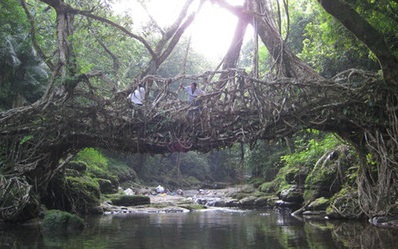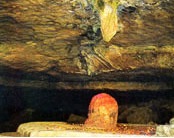Mawsynram
| Line 24: | Line 24: | ||
Mawsynram (Khasi Hills) is 56 kilometres from Shillong, Meghalaya. | Mawsynram (Khasi Hills) is 56 kilometres from Shillong, Meghalaya. | ||
| − | [http://www.mobshare.in/channel/travel/post/IzM4MUduOTB1c2dLTCoqKjM0MDYxNA Mobshare.in] hints that Cherrapunjee has been recorded as the wettest place in the world because there was no meteorological department office in Mawsynram. | + | [http://www.mobshare.in/channel/travel/post/IzM4MUduOTB1c2dLTCoqKjM0MDYxNA Mobshare.in] hints that Cherrapunjee has been recorded as the wettest place in the world because there was no meteorological department office in Mawsynram. |
| + | ===Mawjymbuin Cave=== | ||
| + | [[File: mawjymbuincave.jpg|Natural Shivalinga inside the Mawjymbuin Cave |frame|500px]] | ||
| + | Meghalaya Tourism informs us: This cave, due to years of weathering and due to dripping of mineralized solutions and deposition of calcium carbonate, it has thus given rise to some magnificent stalagmites. These stalagmites are not only important and of great interest for geological research but also because of their exquisiteness. The stalagmite of the Mawjymbuin Cave is shaped into a massive '''Shivalinga.''' The cave also has a dome shaped rock with a flat top called the Symper Rock. | ||
| + | |||
==A life spent in Mawsynram, the wettest place on earth== | ==A life spent in Mawsynram, the wettest place on earth== | ||
Revision as of 17:17, 29 July 2013
This is a collection of articles archived because of the excellence Readers can send additional information, corrections, photographs and even Readers will be able to edit existing articles and post new articles directly
|

Contents |
Mawsynram
Mawsynram (Khasi Hills) is 56 kilometres from Shillong, Meghalaya.
Mobshare.in hints that Cherrapunjee has been recorded as the wettest place in the world because there was no meteorological department office in Mawsynram.
Mawjymbuin Cave
Meghalaya Tourism informs us: This cave, due to years of weathering and due to dripping of mineralized solutions and deposition of calcium carbonate, it has thus given rise to some magnificent stalagmites. These stalagmites are not only important and of great interest for geological research but also because of their exquisiteness. The stalagmite of the Mawjymbuin Cave is shaped into a massive Shivalinga. The cave also has a dome shaped rock with a flat top called the Symper Rock.
A life spent in Mawsynram, the wettest place on earth
AFP | Jul 29, 2013
MAWSYNRAM: Deep in northeast, villagers use grass to sound-proof their huts from deafening rain, clouds are a familiar sight inside homes and a suitably rusted sign tells visitors they are in the " wettest place on earth".
Guinness record: wettest place on earth

Oddly enough, lifelong residents of Mawsynram, a small cluster of hamlets in Meghalaya state have little idea that their scenic home holds a Guinness record for the highest average annual rainfall of 11,873 millimeters (467 inches).
"The rain used to frighten me when I was a young girl, it used to make our lives hell. Today people have it easy," Bini Kynter (who must be "nearly 100 years old") says, wrapping a green tartan shawl tightly around her shoulders.
Unique location
Meteorologists say Mawsynram's location, close to Bangladesh and the Bay of Bengal is the reason the tiny cluster receives so much rain.
"What happens is that whenever any moisture gathers over the Bay of Bengal, it causes precipitation over Mawsynram, leading to a heavy, long monsoon season," Sunit Das of the meteorological department said.
While annual monsoon rain lashed the national capital last week, causing traffic chaos and flooding at the international airport, such problems are mild for Mawsynram.
Development
Just thirty years ago, Mawsynram had no paved roads, no running water and no electricity, making its six-month long monsoon an insufferable experience for its mostly impoverished residents.
Landslides still occur regularly, blocking the only paved road connecting the hillside hamlets. Rainwater still seeps into the mud huts occupied by some villagers. And, while most homes now have electricity, outages are commonplace.
Preparing for the monsoon
Every winter the people of Mawsynram spend months preparing for the wet season ahead, anticipating nonstop rain and no sunshine for several days at a time.
They repair their battered roofs. They cut and hoard firewood, a source of light and fuel for cooking. They buy and store foodgrains, since few will venture out to shop during the wettest months between May and July.
The women make rain covers known as "knups," using bamboo slivers, plastic sheets and broom grass to create a rain shield that resembles a turtle shell, meant to be worn on one's head while being large enough to keep rain off one's knees.
The labour-intensive process of weaving a knup, each one takes at least an hour to complete, occupies the women of the village right through the rainy season, when they are cooped up indoors for months at a time.
Vegetation
Bamboo and broom grass, a delicate, fragrant, olive-coloured grass used to make Indian brooms, are among the chief plants grown in this rocky, hilly region.
Broom grass is dipped in water, flattened using wooden blocks and finally dried on rooftops across Mawsynram. According to Prelian Pdah, a grandmother of nine, this makes the grass stronger and more likely to survive a downpour.
Pdah, 70, spends part of the winter and all of the monsoon season making bamboo baskets, brooms and knups which are bought by visiting businessmen who sell them around the state.
"I don't like the heavy rainfall, it's boring to stay indoors all day. It's annoying," she said.
Cherrapunji [Sohra]: The traditional holder of the record
Although few Mawsynram residents seemed to know or care about their record-holder status, the right to the Guinness title has been hotly disputed by a nearby town, Cherrapunji [Sohra], which used to lay claim to that honour.
Reaction to the rains
In sleepy Mawsynram, many find the record-setting monsoon downright depressing.
"There's no sun, so if you don't have electricity it's very dark indoors, even during the day," Moonstar Marbaniang, the pyjama-clad headman of Mawsynram says.
Those who have second homes elsewhere flee to escape the season. Others catch up on their sleep, according to Marbaniang, whose first name suggests one of the more striking legacies of colonial rule in India's northeast.
Somewhat fittingly for a state whose name means "the abode of the clouds" in the ancient Indian language of Sanskrit, it is not unusual for clouds to drift through people's homes in Mawsynram, leaving a wet film on their furniture.
The grass-covered roofs are meant to muffle the relentless drumming of the rain, but a heavy downpour will usually dislodge the grass to deafening effect.
"We have to talk a little louder to be heard during the monsoon!" 67-year-old Marbaniang said, his mischievous eyes sparkling.
When the monsoon finally ends, there are no parties to mark its exit. The rainy season simply gives way to the repair season, Marbaniang says.
"We don't hold any celebration or festival to mark the end of the rain. We just start drying our clothes outside," he says, flashing a toothless grin.
Despite enduring record amounts of rain, sanguine villagers say there is no other place they would rather live.
Marbaniang, whose children all live in Shillong, says: "I'll never leave, this is my home, I was born here, I will die here."
"Sure, it rains a lot, but we are used to it. We just wait it out."
English names
Historians say the past presence of British soldiers and missionaries in this region has seen many people name their children after random English words or famous historical figures, often with no knowledge of what they might mean.
State capital Shillong's former nickname as the "Scotland of the East" also goes some way to explain the popularity of tartan scarves and shawls, even in the most far-flung and underdeveloped villages of Meghalaya.


